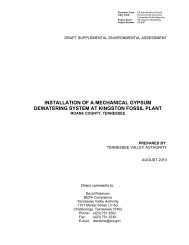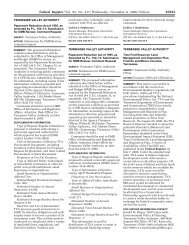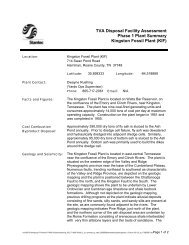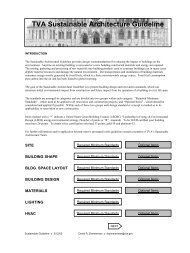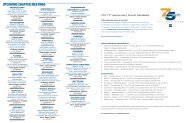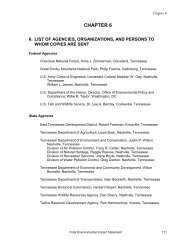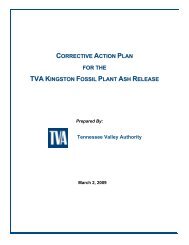Chapter 4: Supporting Information - Tennessee Valley Authority
Chapter 4: Supporting Information - Tennessee Valley Authority
Chapter 4: Supporting Information - Tennessee Valley Authority
You also want an ePaper? Increase the reach of your titles
YUMPU automatically turns print PDFs into web optimized ePapers that Google loves.
Norris Reservoir Land Management Plan<br />
Flowage Easement Tracts<br />
Forecast System<br />
Fragmentation<br />
Indirect Impacts<br />
Macroinvertebrates<br />
Mainstream Reservoirs<br />
Marginal Strip<br />
Maximum Shoreline<br />
Contour<br />
National Ambient Air<br />
Quality Standards<br />
National Environmental<br />
Policy Act<br />
Neotropical Migrant Birds<br />
Physiographic Provinces<br />
Non-TVA lakeshore properties where TVA has (1) the right to flood the land as<br />
part of its reservoir operations, (2) no rights for vegetation management, and<br />
(3) the authority to review plans for the construction of structures under Section<br />
26a of the TVA Act.<br />
The process used for planning the use of TVA public land. TVA staff would<br />
provide a record of actual and prospective uses indicated for particular<br />
properties. A Forecast System record book was prepared for each TVA<br />
reservoir to serve as a general guide for use or development to benefit TVA<br />
staff interests and the local or regional economy. Decisions on the best use of<br />
the property were made, using internal agency expertise. The new land use<br />
planning process will eventually replace the Forecast System as the mechanism<br />
for identifying acceptable uses of TVA public land. A major difference<br />
between the two methods is the involvement of the public in the planning<br />
process.<br />
The process of breaking up a large area of relatively uniform habitat into one or<br />
more smaller, disconnected areas.<br />
Effects which are caused by the action and are later in time or farther removed<br />
in distance but are still reasonably foreseeable (40 C.F.R. § 1508.4).<br />
Aquatic insects, snails, and mussels whose species, genus, etc., can be<br />
determined with the naked eye.<br />
Impoundments created by dams constructed across the <strong>Tennessee</strong> River.<br />
The narrow strip of land owned by TVA between the water’s edge and the<br />
adjoining private property, on which the property owner may construct private<br />
water use facilities upon approval of plans by TVA.<br />
An elevation typically 5 feet above the top of the gates of a TVA dam. It is<br />
often the property boundary between TVA marginal strip property and<br />
adjoining private property.<br />
Uniform, national air quality standards established by the Environmental<br />
Protection Agency that restrict ambient levels of certain pollutants to protect<br />
public health (primary standards) or public welfare (secondary standards).<br />
Standards have been set for ozone, carbon monoxide, particulate, sulfur<br />
dioxide, nitrogen, nitrogen dioxide, and lead.<br />
Legislation signed into law in 1970 which, among other provisions, requires<br />
U.S. government agencies to prepare environmental reviews on proposed<br />
policies, procedures, plans, approvals, and other proposed federal actions.<br />
Approval of a private water use facility or sale of an easement to use federal<br />
land are examples of federal actions subject to NEPA.<br />
Birds which nest in the U.S. or Canada and migrate to spend the winter in<br />
Mexico, Central America, the Caribbean, or South America.<br />
General divisions of land with each area having characteristic combinations of<br />
soil materials and topography.<br />
108<br />
Environmental Assessment





